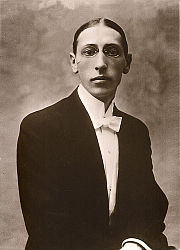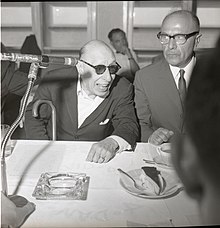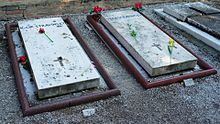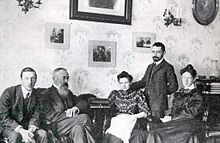| Edit | Map | Home | New Post | New Gallery |
Support
|
 | |
Igor Fedorovich Stravinsky ( June 5 [17], 1882 , Oranienbaum , St. Petersburg province - April 6 , 1971 , New York ) - Russian composer . Citizen of France (1934) and USA (1945). One of the largest representatives of the world musical culture of the XX century. Stravinsky's music is distinguished by stylistic diversity: in the first period of his creative work (his most repertoire compositions), it bears a vivid imprint of the Russian cultural tradition. The stylistics of later compositions betrays, among other things, the influence of neoclassicism and dodecaphony New Viennese School . BiographyIgor Stravinsky was born in 1882 on Swiss Street in Oranienbaum , near St. Petersburg . His father, Fyodor Ignatievich Stravinsky , is an opera singer and soloist at the Mariinsky Theatre . His mother, pianist and singer Anna Kirillovna Kholodovskaya (08/11/1854 - 06/07/1939), was a permanent accompanist at her husband's concerts. The Stravinsky house in St. Petersburg hosted musicians, artists, writers, among whom was F. M. Dostoevsky . Stravinsky took private piano lessons from A. P. Snetkova (from 1896/97 to 1899) and L. A. Kashperova (from December 1899). Later, the composer noted: “The only idiosyncrasy of Mademoiselle Kashperova as a teacher was a complete ban on the use of pedals; I had to hold the sound with my fingers, like an organist; perhaps it was an omen, since I never wrote music that required heavy pedaling. The formation of Stravinsky's musical tastes during this period was greatly influenced by his elder comrade, the composer and pianist I. V. Pokrovsky, who introduced him to Western European music, primarily French (Ch. Gounod, J. Bizet , L. Delibes ,E. Chabrier and others), helping him to free himself from the influence of the musical academism of that time. In his "Dialogues" Stravinsky claims that the closest communication with Pokrovsky, who had a "decisive influence" on his life, refers to the years 1897-1899: "When we met with him, I was still studying at the gymnasium, and he had already graduated from the university; he was exactly that much older than me, so that I could consider him an authority ... Pokrovsky seemed to me someone like a brilliant Baudelaire , as opposed to the esprit beige [provincialism] of my family. Soon I began to spend all my time with him, even at the expense of schoolwork. At the age of 19, after graduating from the Gurevich gymnasium , at the insistence of his parents, he enteredFaculty of Law of St. Petersburg University , at the same time embarking on an independent study of musical and theoretical disciplines. From 1904 to 1906, Igor Stravinsky took private lessons from N. A. Rimsky-Korsakov , who offered Stravinsky classes twice a week, in parallel with his lessons from V. P. Calafati . In 1906, Stravinsky married Ekaterina Gavrilovna Nosenko, his cousin. In 1907 their first son, artist Fyodor Stravinsky, was born, in 1910 their second son, composer and pianist Svyatoslav Sulima-Stravinsky. In the 1900s-1910s, the Stravinsky family lived for a long time on their estate, which was located in Ustilug . Under the guidance of Rimsky-Korsakov, the first compositions were written in 1906 - a scherzo and a sonata for piano , a suite for voice and orchestra Faun and a Shepherdess , etc. Sergei Diaghilev attended the premiere of the suite , highly appreciating the talent of the young composer. Some time later, S. Diaghilev invited him to write a ballet for a production in the Russian Seasons in Paris in 1910. Within three years of collaboration with the Diaghilev troupe, Stravinsky wrote three ballets that brought him world fame - The Firebird ( 1910 ), Petrushka (1911 ) and " The Rite of Spring " ( 1913 ). During these years (mainly in connection with the productions of S. Diaghilev) Stravinsky repeatedly traveled to Paris. In June 1911, shortly after the Paris premiere of Petrushka in Diaghilev 's Ballets Russes , Stravinsky met Eric Satie, whom he defined as "the strangest man I have ever known", but, moreover, called him "the most wonderful "and" invariably witty ". In the autumn of the same year, a meeting and photographing took place in the house of Claude Debussy, where three composers who were directly related to the style of impressionism in music had lunch: its “forerunner” and founder (Erik Satie), the generally recognized leader (Claude Debussy) and Russian follower (Igor Stravinsky), has already indicated his movement towards other styles. Debussy believed that the "young Russian school" fell under foreign influence: "Stravinsky himself dangerously deviates towards Schoenberg , but, by the way, remains the most wonderful orchestral mechanism of this time" . The Russian composer later became acquainted with these words of Debussy and associated them with the enthusiasm with which he accepted the vocal-instrumental cycle " Lunar Pierrot " by Schoenberg, listening to which (in 1912 in Berlin), according to Stravinsky, was a great event in his life. The correspondence between Stravinsky and Satie, which began in 1913, includes dozens of letters. According to Y. Khanon , a researcher of Sati's work, some of Sati's works, especially the ballet Parade (1917) and the cantata Socrates (1918, the author's designation "symphonic drama"), significantly influenced Stravinsky's work. According to G. Filenko, a special turn in the solution of the ancient theme, the archaization of the musical language and fundamentally new methods of musical construction in Socrates turned out to be fruitful for other composers and anticipated the coming neoclassicism of Honegger 's Antigone by almost ten years.(1924), as well as "Apollo Musagete" and " Oedipus Rex " by Stravinsky (1929-1930), outlining in advance all the main features of the new style. Stravinsky himself spoke about Satie's Socrates, as well as about the professional merits of its author, with skepticism and restraint:
At the beginning of 1914, on the eve of World War I , he left with his family for Switzerland . Due to the outbreak of the war, and then the revolution, the Stravinskys did not return to Russia. From the spring of 1915, the composer lived with his family in Morges near Lausanne , from 1920 - mainly in Paris . Among the works of this time are the opera " The Nightingale " based on the fairy tale of the same name by Andersen (1914) and " The Story of a Soldier " (1918). The rapprochement of Stravinsky with the French " Six " dates back to the same time . After the end of the war, Stravinsky decided not to return to Russia and some time later moved to France . In 1919, the composer, commissioned by Diaghilev, wrote the ballet Pulcinella , staged a year later. In 1922, the composer's mother, Anna Kholodovskaya, left Russia and lived in her son's house in Paris. She died in 1939 and is buried in the cemetery of Sainte-Genevieve-des-Bois . Igor Stravinsky dedicated to her the song "Forget-me-not Flower" from "Two PoemsK. Balmont for voice and piano. Stravinsky remained in France until 1940. Here were the premieres of his last Russian compositions - the chamber opera Mavra (1922) and the short choreographic cantata The Wedding (1923) , as well as works written in the neoclassical manner, including the ballets Pulcinella (1920) and Fairy Kiss (1928). In Paris, he first turned to sacred music - he wrote "Our Father" for unaccompanied choir (1928) and the famous " Symphony of Psalms " (1930) to the Latin texts of the Psalter (1930; first performed in December of the same year in Brussels by E. Anserme ) . From 1915, Stravinsky periodically acted as a conductor of his own compositions. In 1924, Stravinsky made his debut as a pianist, performing his own Piano Concerto and Brass Band, conducted by Sergei Koussevitzky . In the early 1930s, Stravinsky wrote the Violin Concerto and the Concerto for Two Pianos. In 1933-1934, commissioned by Ida Rubinstein, together with André Gide , Stravinsky composed the melodrama Persephone . In 1934, Stravinsky became a French citizen, and in 1935 he published (in French) his memoirs entitled Chronicle of My Life. Stravinsky later recalled the Parisian years as the most unfortunate time of his life. In 1938, his eldest daughter, Lyudmila, died, in 1939, his wife (buried in Paris at the Sainte-Genevieve-des-Bois cemetery) and his mother. On March 9, 1940, Stravinsky married again - to Vera Sudeikina , whom he had known since 1922. Since 1936, Stravinsky periodically went on tour to the United States , during which his creative ties with this country were strengthened. In 1937, the ballet " Playing Cards " was staged at the New York Metropolitan Opera House , a year later the concert " Dumbarton Oaks " was performed. Stravinsky was invited to give a course of lectures at Harvard University . In connection with the outbreak of World War II, Stravinsky decided to move to the USA (1939) . He settled first in San Francisco and then inLos Angeles . In 1945 he received American citizenship. Works of this period - the opera " The Adventures of the Rake " (1951), which became the apotheosis of the neoclassical period, the ballets " Orpheus " (1948), Symphony in C major (1940) and Symphony in three parts (1945), Ebony Concerto for clarinet and jazz orchestra (1946). In January 1944, in connection with a performance of an unusual arrangement of the US anthem in Boston , local police arrested Stravinsky and warned that there was a penalty for misrepresenting the anthem . The composer himself refuted this story. From the early 1950s, Stravinsky began to systematically use the serial principle . The transitional composition was the Cantata on poems by English anonymous poets, in which the trend of total polyphonization of music was indicated. The first serial composition was Septet (1953). A serial composition in which Stravinsky completely abandoned tonality was Threni ( Lament of the Prophet Jeremiah , 1958). A work in which the serial principle is absolute is Movements for piano and orchestra (1959) and Variations in Memory of Aldous Huxley for orchestra. In 1966, Stravinsky wrote "Chants for the Dead" ( Requiem canticles) is a small, chamber-style work (in contrast to the large-scale "pathetic" requiems of the romantics), which he considered the final one in his creative career. For decades, Stravinsky toured extensively as a conductor (mostly of his own compositions) in Europe and the United States. Distinguished by his extreme exactingness in observing the performance nuances prescribed by him (tempo, dynamics, accents, etc.), Stravinsky attached great importance to audio recording. In the 1950s and early 1960s, the vast majority of his compositions were recorded under the direction of the author on Columbia Records. The author's audio recordings of Stravinsky as a conductor to this day serve as an important reference point for all new performing interpretations of his music. On September 21, 1962, Stravinsky flew to Moscow , where he conducted his compositions (in October - in Leningrad ). Stravinsky's concerts were enthusiastically received by the musical community of the country. Stravinsky's last completed work is an arrangement for chamber orchestra of two sacred songs by Hugo Wolff (1968). The orchestrations of four preludes and fugues from the Well-Tempered Clavier by J.S. Bach (1968-1970) remained unfinished, and sketches of a certain composition for piano have also been preserved. Stravinsky died on April 6, 1971 in New York from heart failure. He was buried in the cemetery of San Michele in Venice (Italy), in the so-called "Russian" part of it, not far from the grave of Sergei Diaghilev . In 1982, Stravinsky's wife, Vera Bosse, was buried next to Stravinsky's grave . CreativityMain article: List of compositions by Igor Stravinsky
Stravinsky worked in almost all contemporary genres. His creative heritage includes operas, ballets, symphonies, cantatas and oratorios, concertos for solo instruments with orchestra, chamber instrumental and vocal music. Stravinsky's creative career is divided into three periods - Russian, neoclassical and serial. This subdivision is conditional and contradictory, for example, compositions “on a Russian theme” (“Our Father”, “I Believe”, “Rejoice in the Mother of God Virgin”, “Scherzo in the Russian Style”, etc.) Stravinsky wrote in the years that are attributed to the period of neoclassicism , and the appeal to the themes of the past (ballet "Agon", choral Requiem ) is typical not only for the neoclassical, but also for the serial period. Opera " The Rake's Adventures"”(1951) is considered “neoclassical”, although it was already written in the “serial” years and in a completely different language than the ballet “Pulcinella” (1920). Russian periodThe first stage of Stravinsky's musical career (not counting some of his early works) is counted from the writing of the orchestral fantasy "Fireworks" and includes three ballets created by him for the troupe of S. Diaghilev (" The Firebird ", " Petrushka " and " The Rite of Spring "). These works are characterized by a number of similar features: they are all designed for a large orchestra , and they actively use Russian folklore themes and motifs. They also clearly trace the development of stylistic features - from the "Firebird", expressing and emphasizing certain trends in the work of Rimsky-Korsakov, based on pronounced free diatonic consonances (especially in the third act), through the polytonality characteristic of "Petrushka", to deliberately rude manifestations of polyrhythm and dissonance , which are noticeable in The Rite of Spring. In relation to the latter work, some authors (in particular, Neil Wenborn) refer to Stravinsky's intention to create a kind of "hellish" atmosphere. From this point of view, the first performance of The Rite of Spring in 1913 could be considered quite successful: the premiere was very stormy, to the point that Stravinsky himself in his autobiography characterized it as a "scandal" ( French scandale ) [35] . Some witnesses claimed that there were skirmishes in places in the hall, and the second act had to be carried out in the presence of the police. Researchers, however, pay attention to contradictions in various versions of the presentation of events [36] . In addition to the works listed above, this period in Stravinsky's work includes the opera The Nightingale (1916) and three compositions for musical theater - "The Story of a Soldier " (1918), " A Tale about a Fox, a Rooster, a Cat and a Sheep " (1916), " Wedding "(1923), each of which has (in the form of a subtitle) a unique author's designation of the genre. "Neoclassical" periodStravinsky's first neoclassical work was the ballet with singing " Pulcinella " (1920), where the composer relied on the music of Italian composers of the 18th century, especially G. Pergolesi , and clearly stylized his own music (harmony, rhythm, orchestration) in the manner of classicism. To a much greater extent, Stravinsky's individuality manifested itself in the chamber opera Mavra (1922); for this reason, some musicologists consider Mavra to be a milestone work, completing the Russian and beginning the "neoclassical" period of Stravinsky's work. Neoclassicism in the range from the skillful stylization of the music of the past (baroque, classicism, romanticism) to its deep rethinking distinguishes the opera-oratorio "Oedipus Rex " (1927, in Latin text), the ballet "Kiss of the Fairy" (1928, using music by P. I. Tchaikovsky ), Concerto for chamber orchestra " Dumbarton Oaks " (1938). The ballet "Apollo Musagete" (1928), the ballet "Orpheus" (1947) and the melodrama "Persephone" (1933), written on the "antique theme" (based on ancient Greek mythology ), although in terms of composition technique they have nothing in common with classical (that is, ancient) music are also ranked among the works of Stravinsky's neoclassical period. Three symphonies also fit within this period: " Symphony of Psalms " (1930), Symphony in C (1940) and "Symphony in three movements" (1945). Late or "serial" periodIn the 1950s, the composer began to use the serial technique in his compositions . The first experiments with serial technique can be traced in the small compositions of 1952-1953 "Cantata", "Septet" and "Three Songs from William Shakespeare". In "Canticum sacrum", created in 1955 , one of the five parts ( Surge Aquilo ) is completely dodecaphonic. Subsequently, the composer used the serial technique in his compositions "Agon" (1957), " Lamentations of the Prophet Jeremiah " (1958), "Sermon, Parable and Prayer" (1961, the last two are based on biblical texts and motifs), as well as in mysteries "The Flood" (1962), which is a synthesis of excerpts from the Book of Genesiswith medieval English mysteries ; The Deluge also uses the text of the Catholic hymn Te Deum . StyleStravinsky's style cannot be described briefly and unambiguously (as is possible, for example, in relation to the Viennese classic Mozart or the romantic Chopin). The reason for this is in the continuous stylistic searches and compositional and technical experiments that mark the composer's work throughout his life. Due to the variability of Stravinsky's stylistic and compositional-technical preferences, Western historiography has dubbed him the " Proteus of the twentieth century". "Russian" Stravinsky"Russian" in Stravinsky's music, most noticeable in his use of the characteristic features of the genres of peasant and urban folklore (as in the song collections "Jests" and "Cat's Lullabies", in "Svadebka", in "Petrushka") - melodics, harmonies, rhythms, textures, etc. - is not limited to opuses of the so-called Russian period. Explicit and latent echoes of the "Russian" are found in many compositions of the "neoclassical" period (direct, for example, in vocal compositions on the Church Slavonic texts "I Believe", "Hail to the Mother of God" and "Our Father", in the instrumental "Russian Scherzo"; hidden, for example, in the Symphony of Psalms). Stravinsky himself considered himself Russian throughout his life, even taking into account later, completely dodecaphonic music. In his declining years, during a trip to Russia in 1962, the composer gave an interview to one of the central newspapers, in which,
One of the best Russian interpreters of Stravinsky, G. N. Rozhdestvensky, in a book devoted, among other things, to the study of his composition technique, wrote:
"Serial" StravinskyThe reactions of critics and fellow composers (for example, D. D. Shostakovich and P. Boulez) to Stravinsky's later work were ambiguous. Stravinsky's serial experiments were perceived by some as a "formalistic" trend, as a "final break" with the national tradition, by others as an attempt to "objectify" the musical language, as a belated desire to give the language a "universal" character [41 ] . From the point of view of compositional technique, unlike the Novovenets (Schoenberg, Webern and Berg), Stravinsky at first treated the series very freely, wrote short series (did not use all 12 tones), allowed repetition of tones, combined sounds of different pitch into “pseudo-triads”, did not extend the series to the entire composition, arranging only separate parts in serial technique. The use of serial technique is recorded in the "Movements" for piano and orchestra (1959), the cantata "Sermon, Parable and Prayer" (1961), the musical performance "The Flood" (1962), the sacred ballad "Abraham and Isaac" (1963), "Variations in memory of Aldous Huxley" for orchestra (1964), "In memory of T. S. Eliot" for male choir and chamber ensemble (1965), "Chants for the Dead" (1966). Unlike E. Krenek , Stravinsky rotated not only six-sound, but also four-sound, as well as twelve-sound segments of the main serial forms, predominantly “chromatically” (“diatonic” rotation was used by him only once in “Movements”) The folding of rotational segments into chord verticals and their sequence formed the basis of the serial harmony of the late Stravinsky. The transfer of emphasis from polyphonic to harmonic ways of developing a 12-tone series allowed the composer to create an individual author's version of the serial technique. According to V. V. Glivinsky, “serial-rotation tables, as the main generative factor of the text of seven late scores by Stravinsky, reveal a deep relationship with the databases used in the field of modern information technologies” . Arrangements, arrangementsThroughout his life, Stravinsky constantly reworked his own and other people's compositions (author's compositions, Orthodox music, folk songs). Most often, Stravinsky's adaptation was an arrangement of his own early work for a different (compared to the original) instrument or set of instruments (for example, many vocal works of the Russian period, written for voice and piano, were later arranged for voice with an ensemble of instruments). In some cases, the processing was accompanied by a reworking of the original music (reduction, variation, less often expansion, updating of harmonization), in such cases one speaks of an "edition" (two editions of the piano Tango - for violin and piano and for violin and instrumental ensemble). An example is the music for the ballet Petrushka , to which the composer returned repeatedly. The composition was completed in 1911 (the so-called “first edition”, or “original edition”) and subsequently underwent various revisions: in 1921 (treatment of three numbers for piano), in 1932 (arrangement of “Russian Dance” for violin and piano), in 1947 (second version of the ballet, re-orchestration), in 1947 (suite from the ballet for symphony orchestra), in 1965 (third version of the ballet). Some arrangements by Stravinsky strike with paradoxicality. So, in 1949, the composer replaced the canonical Orthodox texts (in Church Slavonic) in the small choral compositions " Our Father " (1926), " The Symbol of Faith " (1932) and " Virgin Mary, Rejoice " (1932) with canonical texts of Catholics (in Latin; respectively Pater noster , Credo and Ave Maria ), without the slightest change (completely Russian in style) of the music.
Stravinsky processed the works of other composers and folk music within the same very flexible boundaries - from "simple" instrumentation (spiritual songs by Hugo Wolf , madrigals by Carlo Gesualdo , Russian folk song " Dubinushka ") to deep authorial rethinking ("Pulcinella" to the music of J. B. Pergolesi , "Kiss of the Fairy" to the music of P. I. Tchaikovsky). |
Author: Sonya Version: 1 Language: English Views: 0
|
Short link: https://www.sponsorschoose.org/a240
Short link to this version: https://www.sponsorschoose.org/n268
Created by Sonya at 2023-07-03 08:30:27
Last modified by Sonya at 2023-07-03 08:42:53
|






